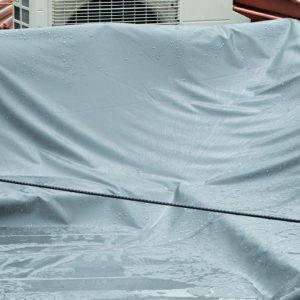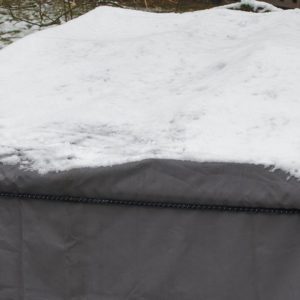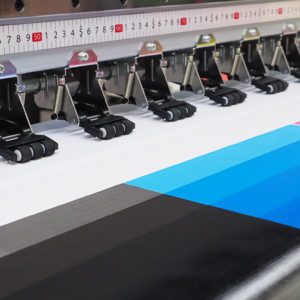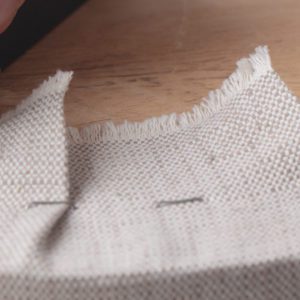Vinyl coated fabrics are valued across industries for their durability, water resistance, and versatility. From heavy-duty tarps and upholstery, to delicate print media designed for high quality graphics, these fabrics can perform well for years if they’re cared for properly. Knowing how to care for vinyl coated fabrics is imperative to its performance. Storage, maintenance, and cleaning practices are what make the difference between material that lasts and material that fails too soon.
Why Proper Care for Vinyl Coated Fabric Matters
Vinyl fabrics are durable, but not indestructible. How they’re stored, maintained, and cleaned has a direct impact on their lifespan and performance.
Industrial vinyl fabrics are used in applications like truck covers, awnings, tarpaulins, bounce houses, and more. Small marks or blemishes often don’t affect performance, but creasing, cracking, or prolonged exposure to moisture can cause lasting damage.
Print media vinyl is manufactured with a smooth, uniform surface designed to accept ink. Because every scratch, speck of dust, or fingerprint shows up in the final print, print media vinyl is shipped and stored in protective wrapping and must be handled with extra care.Proper Storage Keeps Vinyl Fabric Flexible, Clean, and Ready to Use.
Roll support: Store rolls with full-length support on sturdy cores. This prevents sagging, edge distortion, and collapsing. Print Media Rolls should remain in their protective wrapping and be supported evenly whether stored vertically on end caps or on racks.
Climate control: Keep rolls in a stable, indoor environment. Heat makes vinyl sticky and brittle, while cold can cause cracking. Ideally, store print media rolls in the same climate-controlled space where printing takes place. This reduces curling and acclimation issues.
Covering: Use breathable covers to protect from dust and airborne contaminants. Print media vinyl should always remain wrapped until it’s ready for use.
Handling for Print Media Rolls: Careful handling is just as important as storage. Keep rolls wrapped until loading, handle them with clean gloves to avoid fingerprints, and never drag or drop rolls. Damaged edges or contaminated surfaces lead directly to printing defects.
Minimize Damage to Vinyl Fabric Rolls by Avoiding These Mistakes
- Folding: Creases introduced by folding are often permanent and weaken the vinyl along those lines.
- Stacking heavy rolls: Excess weight causes flattening, denting, or pressure marks that are difficult to remove.
- Uncontrolled storage spaces: Garages, attics, or warehouses with extreme seasonal fluctuations shorten the usable life of vinyl.
- Contact with other plastics: Prolonged pressure between vinyl and other plastics can cause sticking or surface transfer.
- Print Media Vinyl: avoid exposing uncovered rolls to dust, dragging rolls, or dropping them, since edge damage directly affects print quality.
Maintenance for Vinyl Fabric Rolls
Maintenance is about keeping vinyl fabrics in good condition during storage and use. Unlike cleaning, which removes dirt, maintenance focuses on preventing damage and catching issues early.
- Regular inspections: Check rolls for early signs of cracking, tackiness, or discoloration. Inspect finished products for wear at edges, seams, or folds. Inspect print media rolls for dust, dents, or surface marks. Even small flaws can ruin a print job.
- Rotate stock: Use older rolls first (“first in, first out”) to keep material from sitting too long and degrading. Be especially mindful with high-value print media rolls — they shouldn’t sit for months unopened.
- Protection in storage: Keep rolls covered to prevent dust buildup and accidental abrasion. Print media vinyl should remain wrapped until it’s loaded into the printer.
- Safe handling: Move rolls carefully to avoid bending or dropping. Always support the full length of the roll. Handle print media rolls with clean, lint-free gloves to avoid fingerprints and keep the surface pristine.
How to Clean Vinyl Fabric
Cleaning vinyl is pretty straightforward. In general, wiping with a damp cloth or using mild detergents and a soft cloth is all that’s needed.
Industrial Vinyl Fabric Cleaning Instructions
- Use a neutral liquid detergent diluted in water and soft cloths, sponges, or soft-bristle brushes.
- Rinse thoroughly with clean water to remove detergent residue.
- Dry completely before rolling or storing.
- Avoid strong solvents, abrasives, bleach, or excessive pressure washing.
Print Media Vinyl Cleaning Instructions
- If needed, gently wipe with a soft, lint-free cloth before loading into the printer.
- Never use detergents, solvents, or abrasive tools on the print surface—these will compromise print quality.
- Focus instead on keeping rolls covered, wrapped, and handled in a dust-free environment so cleaning is rarely necessary.
What to Avoid When Cleaning Vinyl Fabric
- Strong solvents (turpentine, acetone, MEK, hydrocarbons, etc.) — these break down the PVC coating.
- Abrasive powders or pads — they scratch and thin the surface.
- Harsh chemicals like bleach, caustics, or strong oxidizers — they corrode and weaken the protective layer.
- Excessive pressure washing — high bar pressure can damage the coating or force water into seams.



























